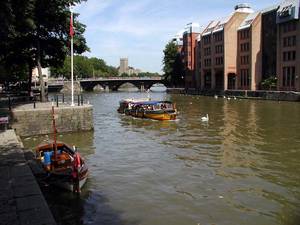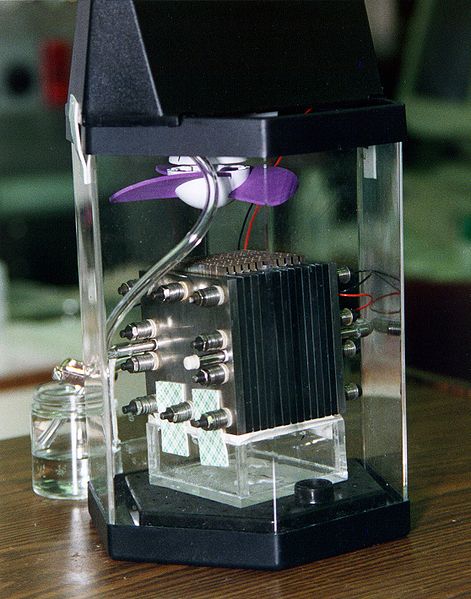Hydrogen on the Waves - Britains 1st Fuel Cell Powered Passenger Boat
Interview with
Chris -
We've heard from Mark Redwood that hydrogen can be produced in one way using bacteria. There are also others. It's a very clean fuel, but how can we actually use it in practice?
One way is to feed in into a process which is called a fuel cell that can generate electricity and you then use this to drive an electric motor which is connected to a drive wheel or even a propeller. Ben Valsler has been to Bristol to meet Jas Singh who is from Auriga Energy and Keith Dunstan from the Bristol Packet boat company to hear about a project that they're launching to power boats using this new technology...
Ben - I'm standing down on the docks near Narrow Quay in Bristol, surrounded on all sides by water and boats - small pleasure boats off to the right, big industrial-looking things on the left. I'm joined by Jas Singh, the owner of Auriga Energy. Jas, what's your interest in marine technology?
Jas - I'm in here to build hydrogen powered boats and to operate them to bring zero carbon operations to water op so that we can actually help to reduce the global warming gases that are plaguing us.
 Ben - Why hydrogen in particular? What are the other options and why have you gone for that one?
Ben - Why hydrogen in particular? What are the other options and why have you gone for that one?
Jas - Hydrogen provides the most sustainable clean fuel around because hydrogen is the most abundant element in the universe, and when operated through a fuel cell system, which is a highly efficient electrical generation system, the output exhaust is pure water. So, it is the most emission free energy generation system that you can imagine.
Ben - So, just take me through the fuel cell itself. How does that actually work?
Jas - A fuel cell is a reverse electrolysis in that, if you remember from your school days, if you put electrodes in a beaker of water, you can break up the water into its consistent parts of hydrogen and oxygen. In a fuel cell, you bring hydrogen and oxygen together with a catalyst and you recreate water as the exhaust, and you liberate some electrons and produce lots of electricity. And then we can use electricity to power whatever we need. In this case, lights and motors.
Ben - So the hydrogen that you're using as a fuel, where does that actually come from?
Jas - Hydrogen at the moment is a by-product of a lot of the chemical industries, and in essence, if we didn't use it for fuel cell systems, it would be flared off or just wasted. And in future, and also happening at present is that we will generate hydrogen from renewable resources and therefore, hydrogen will be a totally green fuel.
Ben - But how else do you make hydrogen?
Jas - Hydrogen can be made by storing energy from wind power, from solar, from wave, tidal, and in addition, the one that is my favourite is recycling waste because we generate waste and we're recycling it. There was a study done in London by the London Hydrogen Partnership that if they use the energy generated from the waste recycling program that they've got in place, they could manufacture enough hydrogen to run the entire bus fleet in London, and London has 10,000 buses intensely used. So that is one of the many ways forward and, waste recycling through various anaerobic digestion systems kills two birds with one stone.
Ben - And how do you actually store the hydrogen on the boat?
Jas - Hydrogen is stored in a filament wound tank, a purpose-built tank of compressed gas. In the future, there is research going on around the world to encapsulate hydrogen in porous metals in essence which will be more efficient in volume terms. So that's the direction the world is heading in. At the moment, it's in compressed gas at 350 bar.
Ben - Keith Dunstan, you run the Bristol Packet boat company here and you're helping to design this hydrogen powered boat. At the moment, what is it that boats actually run on?
 Keith - Well all boats run on diesel. The whole marine industry runs on diesel and it's one of the highest producers of carbon, more than aviation or any other industry. Ships going around the world are hugely polluting and we run diesel boats all around the docks here and hopefully, one day, we'll be running them on hydrogen which should be a lot cleaner, more efficient, and cheaper. Hopefully, that's the only way it's going to really happen when people start realising that diesel is going to get more and more expensive, and eventually will run out and we'll need something else.
Keith - Well all boats run on diesel. The whole marine industry runs on diesel and it's one of the highest producers of carbon, more than aviation or any other industry. Ships going around the world are hugely polluting and we run diesel boats all around the docks here and hopefully, one day, we'll be running them on hydrogen which should be a lot cleaner, more efficient, and cheaper. Hopefully, that's the only way it's going to really happen when people start realising that diesel is going to get more and more expensive, and eventually will run out and we'll need something else.
Ben - So, can you just strap a hydrogen fuel cell and a big tank full of hydrogen onto an existing boat or do we need to do a bit more in order to integrate this?
Keith - Well you could do that, but I don't think you get anyone to allow you to carry passengers! I think you've got to get a little bit more serious about the regulations and how you can do it safely. And that's what we're trying to prove at the moment - how you can do it safely. When we first went to the marine coastguard agency and said we're going to build a hydrogen fuel cell boat they said, "What? What is that? We haven't got any regulations. We know nothing about it. It would probably take five years before we actually allow you to build this thing." Since then we've been in touch with various ministers and who have put a bit of pressure on the MCA, and within six months, they came up with some regulations. They actually just decided to use the German regulations - as long as we comply with the German regulations, we can build a passenger boat now, carrying any number of passengers.
Ben - So obviously, there's been lots of legal red tape to go through. What about the engineering challenges? How have you actually built the new boat?
Keith - It's a pretty standard boat. It's just that it's fairly sleek. We're not using a huge amount of power on this boat. We're up to 10 horsepower so the boat has got to be fairly lightly built. It's got to be robust, strong enough to withstand being knocked around the docks here. We've also got to bulkhead off the various elements of this thing. We've got a fuel tank and we've got the fuel cells, and we don't want the two to be in any way connected - We don't want sparks in either of those areas! There's three compartments you need in any of these systems. You need a compartment for your fuel cells, a compartment for the fuel tank, and a compartment for your electric motors and batteries, and all the things that spark.
Ben - Jas, we've just mentioned a 10-horsepower engine. That doesn't sound like a lot. How much energy can you get from a fuel cell?
Jas - Fuel cells can produce almost infinite energy and that they're scalable to whatever size you want. At this moment in time, there are buses running throughout the world. In London for example, there are five buses running which have over 100 kilowatts of power onboard. In the future, we see even bigger fuel cell systems. Big corporations such as Siemens are working on megawatt size fuel cell systems, which will be available to provide stationary power to big plants.
Ben - And Keith, coming back to you, how does this compare to an engine that you would see in one of these boats around us. Again, 10 horsepower doesn't sound like a lot of power. Is that enough?
Keith - I think it will be enough. We're told by a lot of people who are very experienced in electric motors and steam engines, it's very comparable. When you say 10 horsepower for diesel engine, you need to get to maximum revs before you get that 10 horsepower - 10 horsepower in an electric motor is there right from the beginning the torque, right from your very first revolution, is 10 horsepower, so it's absolutely there. I think we probably have enough. Anyway, if we don't, we'll add some more fuel cells!
Ben - And what's the long term plan? Jas, coming back to you, clearly, this is a bit of a pilot study and now, you're finally going to get something on the water. Where do you take it from there?
Jas - This is a pathway project to clear all the blockages to introduce this as a permanent installation. So where we take it is that once we've done our demonstration, cleared all the pathways, we then want to generate the hydrogen locally and introduce fuel cell hydrogen operations throughout the Bristol harbour area and reduce the CO2 output.
Chris - That was Jas Singh from Auriga Energy and before him, Keith Dunstan from the Bristol Packet Company, and in partnership with the Engineering and Physical Sciences Research Council, that company, Auriga are teaming up with universities across the country to research better ways to make store and use hydrogen. So we could be seeing hydrogen transport popping up nationwide before too long.










Comments
Add a comment